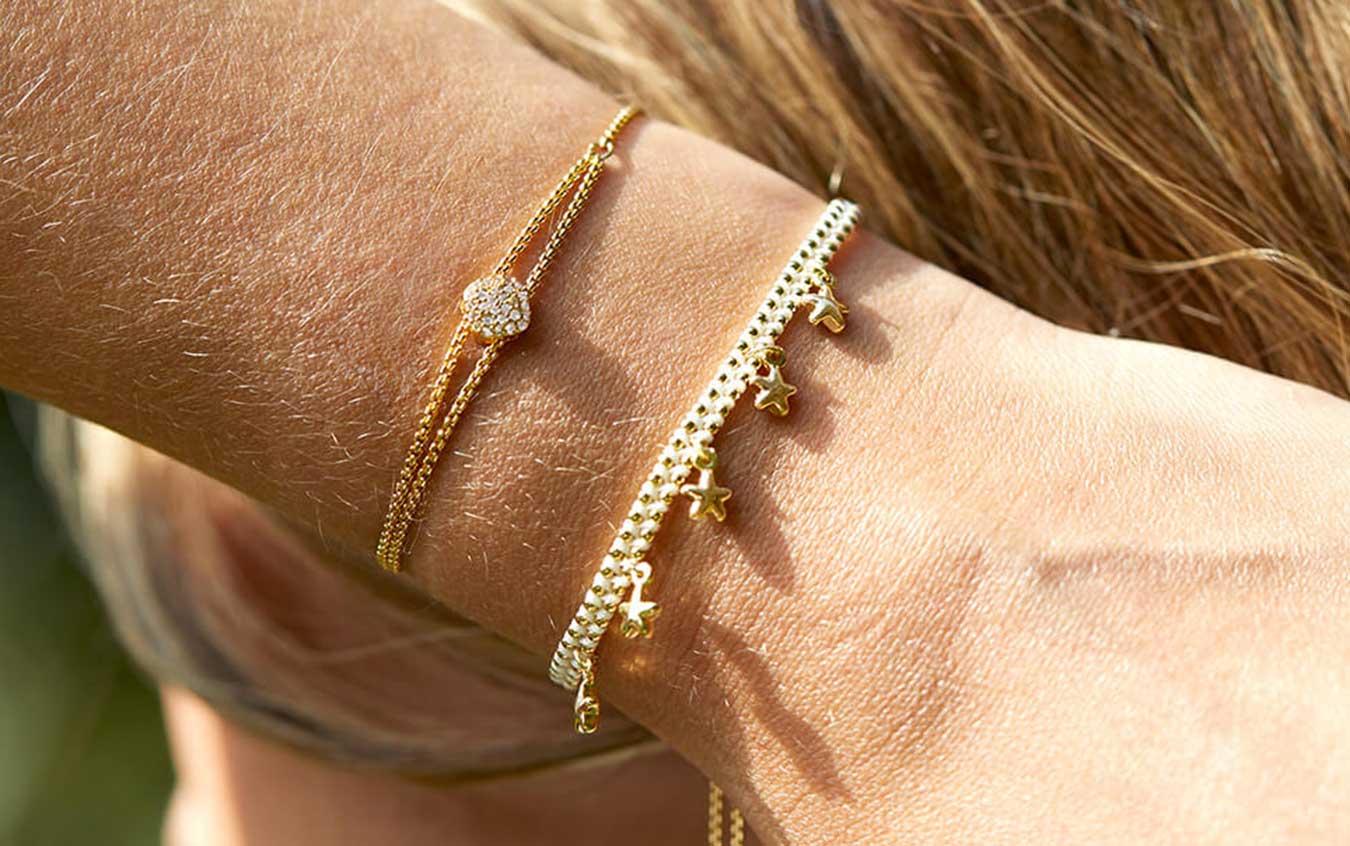Do you adore the elegant shine of gold-plated jewelry but find yourself perplexed when it starts to tarnish? What causes this to happen, and can it be prevented?
If you’re wondering about the longevity of your gold-plated accessories – whether rings, bracelets, necklaces, or earrings – we will answer all your questions. Let’s explore why gold-plated jewelry tarnishes and how to care for it to maintain its beautiful appearance.
How Is Gold-Plated Jewelry Created?
Gold-plated jewelry is produced using a method known as electroplating. The gold plating technique involves coating a base metal – commonly silver, brass, or copper – with a thin layer of gold, creating the appearance of solid gold.
Here’s a breakdown of the electroplating process:
- Base Metal Selection: Common metals used as the base for gold plating include copper, brass, and silver. The choice of base metal influences both the durability and cost of the final piece. Sterling silver is a popular base, often resulting in a higher price point compared to brass or copper.
- Cleaning and Preparation: The base metal undergoes a thorough cleaning process to remove any oils, debris, or contaminants. This step is crucial for ensuring the gold layer adheres properly.
- Electroplating Bath: The cleaned base metal is placed into an electroplating solution containing gold ions, often derived from gold chloride or gold cyanide.
- Application of Electrical Current: An electrical current is passed through the solution, causing the gold ions to bond with the base metal, creating a thin, even layer of gold. The thickness of this layer can be controlled during this step, with thicker coatings offering greater durability.
- Rinsing and Drying: Once the plating is complete, the jewelry is carefully rinsed and dried.
- Quality Inspection: The final product undergoes a thorough inspection to ensure it meets quality standards. Any imperfections are corrected before the jewelry is considered complete.
Will a Gold Plated Bracelet Tarnish?
Without proper care, even longlasting jewelry can tarnish. So can a gold plated bracelet. Tarnishing occurs when the thin layer of gold on your jewelry reacts with substances it comes into contact with during everyday use.
However, high-quality pieces like 8mm moissanite gold tennis bracelets often maintain their luster longer due to their superior craftsmanship and materials, making them a popular choice for those seeking both elegance and durability.
Here’s a closer look at some of the factors contributing to tarnishing:
- Chemical Reactions: Gold-plated jewelry can tarnish when exposed to various chemicals found in everyday products like perfumes, lotions, and even certain foods. These substances can cause the gold layer to oxidize or corrode, leading to discoloration.
- Quality of Gold Plating: The thickness and quality of the gold plating significantly impact how well the jewelry resists tarnishing. Thicker layers of gold are more resilient and less prone to wear and tear compared to thinner layers.
Common Causes of Tarnishing
Here are some everyday items and environmental factors that may accelerate the tarnishing of your gold-plated jewelry:
- Sulfur Compounds: Found in household products, certain foods, and environmental pollution, sulfur compounds can lead to the fading and discoloration of gold-plated items.
- Cosmetics and Lotions: Applying lotions, makeup, or perfumes before putting on your jewelry can expose the gold plating to chemicals that may cause tarnishing. To minimize this risk, always apply these products before accessorizing.
- Cleaning Products: Harsh chemicals in household cleaners, such as bleach or ammonia, can damage the gold layer if they come into contact with your jewelry. Always remove your jewelry before using such products.
- Natural Wear and Tear: Regular use of your gold-plated jewelry can gradually wear down the gold layer, especially when exposed to sweat, oils, and friction. Over time, this can lead to tarnishing and loss of shine.
- Chlorinated Water: The chlorine found in swimming pools and hot tubs can cause gold-plated jewelry to tarnish more quickly. Always remove your jewelry before swimming or soaking in a hot tub.
- Environmental Exposure: Even with the best care, gold-plated jewelry may naturally tarnish over time due to exposure to oxygen and humidity.
Factors Influencing the Longevity of Gold Plating
To ensure your gold-plated jewelry lasts as long as possible, consider these factors:
- Thickness of the Gold Layer: The thicker the gold layer, the more resistant the jewelry will be to tarnishing. Thinner layers are more prone to wear and tear, similar to how nail polish chips and fades over time.
- Frequency of Wear: Jewelry that is worn frequently is more likely to tarnish sooner due to exposure to the elements. For pieces you want to last longer, consider reserving them for special occasions.
- Base Metal: The type of metal used as the base for the gold plating plays a significant role in how quickly the jewelry tarnishes. Some metals, like copper, are more prone to corrosion, while others, like sterling silver, may help extend the life of the gold layer.
- Care and Maintenance: Proper care can significantly extend the life of your gold-plated jewelry. Gently cleaning your jewelry with a mild soap solution and a soft cloth, and avoiding abrasive materials, can help preserve the gold layer.
- Storage: Storing your gold-plated jewelry in a dry, airtight container can prevent exposure to moisture and air, which can accelerate tarnishing. Keep each piece in a separate compartment to avoid scratches and other damage.
Preventing and Managing Tarnish
Although gold-plated jewelry is prone to tarnishing, with the right care, you can maintain its brilliance and prolong its lifespan. Here are some effective tips to help you prevent and manage tarnish:
- Gentle Cleaning: Regularly clean your gold-plated jewelry using a soft, damp cloth to remove dirt, oils, and other residues. Avoid using harsh chemicals, abrasive materials, or stiff brushes, as these can scratch or wear down the gold layer.
- Proper Storage: Store your jewelry in a cool, dry place away from direct sunlight and humidity. Use individual soft pouches or a jewelry box lined with fabric to protect each piece from scratches and minimize exposure to air, which can accelerate tarnishing.
- Mindful Wearing: Remove your jewelry before engaging in activities that may expose it to harsh conditions. This includes exercising, cleaning with household chemicals, and swimming, especially in chlorinated water. Such activities can cause the gold layer to wear off more quickly.
- Regular Maintenance: Periodically inspect your jewelry for any signs of wear or tarnish. If you notice the gold plating starting to fade, consider having the piece re-plated by a professional jeweler. This can restore its original shine and extend its life.
Bottom Line
SO, will a gold plated bracelet tarnish? Yes, it will, but with proper care, you can extend the life of your cherished pieces. By understanding that tarnishing is a natural aspect of gold-plated jewelry and following the simple tips provided, you can reduce and even reverse the effects of tarnish.
Keep an eye for more latest news & updates on Tribune Breaking!







